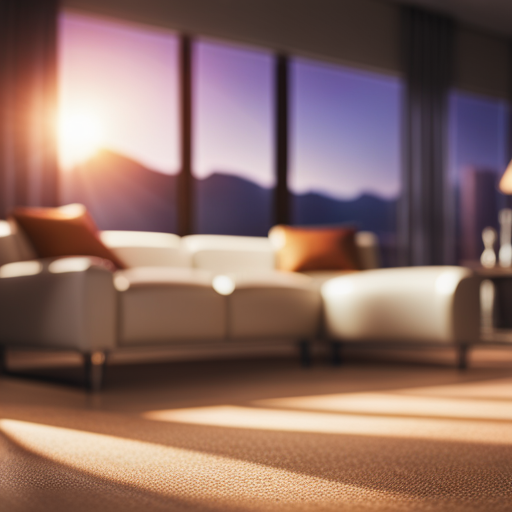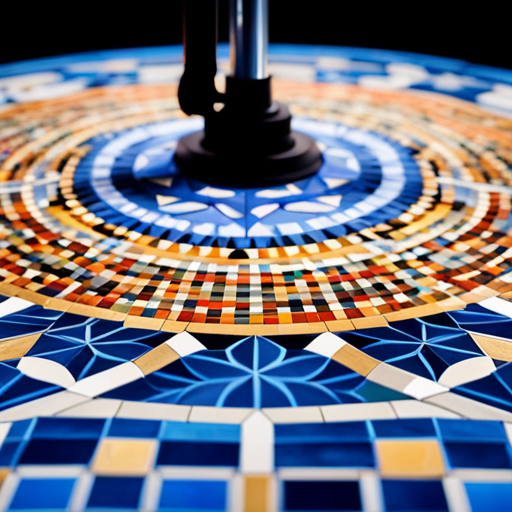Eco-Friendly Bamboo Flooring: Pros and Cons

Like a sturdy and sustainable forest giant, bamboo flooring stands tall as an eco-friendly alternative to traditional hardwood. This article explores the numerous advantages and potential drawbacks of choosing bamboo flooring for your home.
From its environmental benefits to its durability and aesthetic appeal, we’ll delve into the pros and cons of this versatile and cost-effective flooring option.
Whether you’re a conscious consumer or a design enthusiast, this comprehensive guide will help you make an informed decision.
Environmental Benefits of Bamboo Flooring
When considering the environmental benefits of bamboo flooring, it is important to evaluate its impact on resource sustainability and carbon footprint reduction. Bamboo stands out as a highly sustainable material due to its rapid growth and regenerative properties. Unlike hardwood trees that take decades to mature, bamboo reaches full height in just 3-5 years and can be harvested without killing the plant, making it a highly renewable resource.
Bamboo forests play a vital role in carbon sequestration, absorbing more CO2 and producing more oxygen than traditional hardwood forests. Furthermore, the eco-friendly production process of bamboo flooring adds to its environmental benefits. The manufacturing of bamboo flooring involves minimal waste, and the adhesives used are often low in volatile organic compounds (VOCs), reducing harmful emissions.
Additionally, the use of bamboo as a building material can help reduce pressure on traditional hardwood forests, preventing deforestation and habitat destruction. By opting for bamboo flooring, consumers can contribute to the preservation of natural resources and the reduction of their carbon footprint, making it a compelling choice for environmentally conscious individuals and businesses.
Durability and Longevity
When considering bamboo flooring, durability and longevity are essential factors to explore. It is important to compare the durability of bamboo flooring to traditional hardwood options, as well as to understand the maintenance and care required to ensure its longevity.
Bamboo Vs Traditional Hardwood
Bamboo flooring exhibits comparable durability and longevity to traditional hardwood, making it a viable and sustainable alternative for environmentally conscious consumers.
Bamboo’s sustainability is a key factor in its favor, as it is a fast-growing grass that reaches maturity in as little as 3-5 years, while traditional hardwood trees can take decades to reach harvestable maturity.
Despite being a grass, bamboo flooring is impressively durable, often ranking higher on the Janka hardness scale than many hardwood options. When properly maintained, bamboo flooring can withstand heavy foot traffic and is highly resistant to scratches and dents.
Additionally, advancements in bamboo flooring technology have addressed concerns about its susceptibility to water damage, making it a practical choice for areas prone to moisture.
This demonstrates that bamboo flooring offers a comparable level of durability and longevity to traditional hardwood, making it a sustainable and environmentally-friendly choice.
Maintenance and Care
An article determiner wasn’t provided. Can you please provide the article determiner you’d like me to use?
When it comes to maintaining and caring for eco-friendly bamboo flooring, proper upkeep is essential to ensure its durability and longevity. Here are some key aspects to consider:
| Cleaning Tips | Preventive Maintenance |
|---|---|
| Use a soft-bristle broom or microfiber mop to clean regularly | Place doormats at entrances to minimize dirt and debris |
| Avoid excessive water and use a damp mop for spills | Use furniture pads to prevent scratches and dents |
| Regularly vacuum with a floor brush attachment | Control humidity levels to prevent warping |
For long-term care, it’s important to be aware of repair options and invest in preventive maintenance to prolong the life of the bamboo flooring. This includes periodic refinishing and addressing any minor damages promptly.
This meticulous care and attention contribute to the long-term durability and aesthetics of bamboo flooring. Now, let’s delve into its aesthetic appeal and versatility.
Aesthetic Appeal and Versatility
When it comes to bamboo flooring, one of its most appealing aspects is its natural beauty. The unique grain patterns and colors of bamboo can add warmth and character to any space.
Additionally, bamboo flooring comes in a wide range of design options, making it a versatile choice for various interior styles and preferences.
Bamboo’s Natural Beauty
With its natural elegance and wide range of design options, bamboo flooring offers a visually appealing and versatile choice for environmentally conscious consumers.
The natural elegance of bamboo stems from its distinctive grain patterns and warm hues, adding a touch of sophistication to any space. As a sustainable material, bamboo’s beauty is enhanced by its eco-friendly properties, making it an attractive option for those seeking environmentally responsible flooring solutions.
Additionally, bamboo’s versatility allows for various installation patterns, including traditional, modern, or custom designs, catering to diverse aesthetic preferences. Its adaptability to different decor styles further enhances its natural beauty, making it a popular choice for interior designers and homeowners alike.
From sleek and contemporary to rustic and charming, bamboo’s aesthetic appeal and versatility make it a timeless and sustainable flooring option.
Versatile Design Options
Bamboo flooring offers versatile design options that cater to diverse aesthetic preferences, allowing for various installation patterns, from traditional to custom designs. This design flexibility enables homeowners to create unique spaces that reflect their personal style.
The sustainability benefits of bamboo flooring further enhance its appeal, providing environmentally conscious consumers with a durable and eco-friendly flooring option.
The versatile design options of bamboo flooring also include a wide range of color variations, finishes, and plank sizes, allowing for seamless integration into any interior design scheme. Additionally, the option to install bamboo flooring in different patterns, such as herringbone or chevron, adds a touch of elegance and sophistication to any space.
Maintenance and Care Considerations
To ensure the longevity of eco-friendly bamboo flooring, it is essential to implement a regular maintenance and care routine. Eco-friendly cleaning solutions are recommended to preserve the natural properties of bamboo while effectively removing dirt and grime. It’s important to avoid harsh chemicals that can damage the bamboo and opt for gentle, non-abrasive cleaners. Preventive maintenance is also crucial in caring for bamboo flooring. Using furniture pads to prevent scratches, placing mats at entryways to trap dirt, and promptly cleaning up any spills can significantly prolong the life of the flooring.
Regular dusting and sweeping, as well as periodic mopping with a damp mop, are essential for keeping bamboo floors clean and well-maintained. However, excessive moisture should be avoided as it can cause warping or damage to the bamboo. Additionally, it’s advisable to trim pets’ nails regularly to prevent scratches on the flooring.
By adhering to an eco-friendly cleaning regimen and implementing preventive maintenance measures, the bamboo flooring can retain its natural beauty and durability for years to come. These practices not only contribute to the sustainability of the flooring but also minimize the need for costly repairs and replacements.
Transitioning into the subsequent section about ‘cost-effectiveness and affordability’, it’s important to note that by maintaining bamboo flooring properly, homeowners can potentially save on long-term maintenance costs and enjoy an affordable, sustainable flooring option.
Cost-Effectiveness and Affordability
After implementing a comprehensive maintenance and care routine, it is imperative to consider the cost-effectiveness and affordability of eco-friendly bamboo flooring as a sustainable option for homeowners.
When evaluating the cost-effectiveness and affordability of eco-friendly bamboo flooring, the following aspects should be taken into account:
-
Installation Process: The installation process for bamboo flooring is generally more cost-effective compared to traditional hardwood floors. Bamboo flooring can often be installed as a ‘floating floor’ without the need for adhesives, reducing installation time and labor costs. Additionally, bamboo flooring is available in various installation options, including tongue and groove, click-lock, or nail-down, providing flexibility and potentially lowering installation expenses.
-
Cost Comparison: While the initial cost of eco-friendly bamboo flooring may be slightly higher than some conventional flooring options, it is essential to consider the long-term cost savings. Bamboo flooring’s durability and low maintenance requirements can result in significant cost savings over time, making it a financially prudent choice for homeowners.
-
Sustainability Benefits: The affordability of eco-friendly bamboo flooring is further enhanced by its sustainable nature. Bamboo is a rapidly renewable resource, which means that it can be harvested without causing long-term environmental damage. This sustainability aspect can lead to potential cost savings in the future, aligning with environmentally conscious and cost-effective practices.
Potential Drawbacks and Limitations
Considering the long-term implications of eco-friendly bamboo flooring, it is essential to address potential drawbacks and limitations that homeowners may encounter. While bamboo flooring is a sustainable and stylish option, there are certain factors that need to be considered before making a decision. Two significant drawbacks of bamboo flooring are cost implications and installation challenges.
| Potential Drawbacks | Description |
|---|---|
| Cost Implications | Bamboo flooring can have a higher upfront cost compared to other flooring options, which may deter budget-conscious homeowners. |
| Installation Challenges | The installation of bamboo flooring can be more complex than traditional hardwood, requiring experienced professionals to ensure proper fitting and minimize potential issues. |
The cost implications of bamboo flooring can be a deterrent for some homeowners, especially when compared to more budget-friendly alternatives. Additionally, the installation challenges associated with bamboo flooring may require additional expertise, potentially increasing overall installation costs. Therefore, while bamboo flooring offers numerous benefits, it is important for homeowners to weigh these potential drawbacks against the advantages before making a decision.
Frequently Asked Questions
Are There Any Concerns About the Sourcing and Harvesting of Bamboo for Flooring, and How Can Consumers Ensure They Are Purchasing Sustainably Sourced Bamboo Products?
Sustainable sourcing of bamboo for flooring is crucial. Consumers should prioritize ethical practices by verifying certifications such as FSC or GreenGuard. Harvesting concerns can be mitigated through due diligence and supporting companies with transparent supply chains.
Can Bamboo Flooring Be Installed in High-Moisture Areas Such as Bathrooms or Kitchens, and What Are the Potential Challenges in These Environments?
Bamboo flooring can be challenging to install in high-moisture areas like bathrooms and kitchens due to its moisture sensitivity. Cleaning methods and potential durability concerns should be considered when evaluating its suitability for these environments.
How Does Bamboo Flooring Compare to Other Eco-Friendly Flooring Options Such as Cork or Reclaimed Wood in Terms of Environmental Impact and Longevity?
When comparing eco-friendly flooring options, it’s essential to assess the environmental impact and longevity. Bamboo flooring offers a sustainable choice with its rapid growth, while cork and reclaimed wood also present durable and environmentally conscious alternatives.
What Are the Potential Health Considerations for Individuals With Allergies or Sensitivities to Certain Types of Wood or Flooring Materials When It Comes to Bamboo Flooring?
Health considerations should be taken into account for individuals with allergy sensitivities when considering bamboo flooring. Potential challenges may arise due to the natural resins in bamboo, which could trigger reactions in sensitive individuals.
Are There Any Specific Maintenance Products or Techniques That Are Recommended for Preserving the Natural Beauty and Durability of Bamboo Flooring Over Time?
To maintain the natural beauty and durability of bamboo flooring, use eco-friendly cleaning products and follow recommended preservation techniques. Ensure the products used have sustainability certification to minimize the environmental impact, especially in high moisture installations.
Conclusion
In conclusion, eco-friendly bamboo flooring offers numerous environmental benefits, durability, versatility, and affordability.
However, it also comes with maintenance considerations and potential limitations.
Overall, bamboo flooring presents a sustainable and attractive option for homeowners seeking a green and stylish flooring solution.
As the saying goes, ‘Bamboo flooring is a breath of fresh air in the world of sustainable home design.’

Rubin Everest, a seasoned expert in the world of flooring, brings a wealth of knowledge and passion to the surface. As the mind behind ebbow.com, Rubin is dedicated to sharing insights on the latest trends, innovative solutions, and expert advice in the realm of flooring. Whether you’re seeking practical tips for installation or design inspiration, Rubin Everest is your go-to source for all things flooring-related, making your journey to the perfect floor an informed and enjoyable experience.





